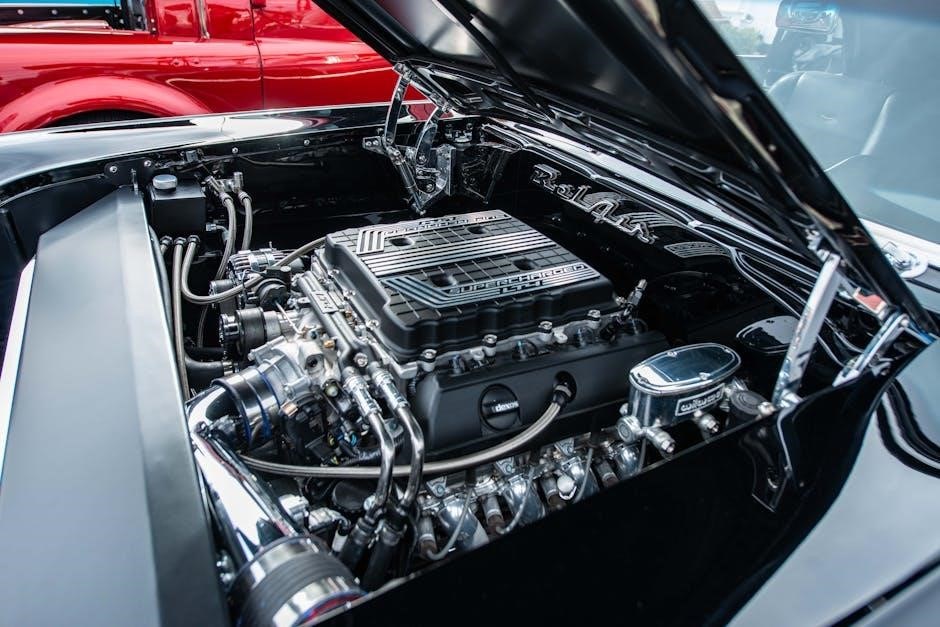The LS motor and manual transmission combination offers unparalleled performance, durability, and driving engagement. Popular among enthusiasts, this setup delivers a cost-effective, powerful, and precise driving experience.
1.1 Overview of LS Motor Popularity
The LS motor has gained immense popularity due to its exceptional performance, affordability, and widespread availability. Known for its durability and versatility, the LS engine is a top choice for enthusiasts and builders. Its compact design and lightweight construction make it ideal for various applications, from daily drivers to high-performance builds. The LS motor’s reliability and ease of modification have cemented its reputation as a favorite for swaps. Additionally, the abundance of aftermarket support and interchangeable parts further enhance its appeal. When paired with a manual transmission, the LS motor delivers a driving experience that combines power, precision, and control, making it a preferred option for those seeking an engaging and responsive setup.
1.2 Benefits of Manual Transmission with LS Motor
Pairing the LS motor with a manual transmission offers numerous advantages, including enhanced driver engagement and precise control over gear selection. This setup allows for better fuel efficiency and lower operating costs compared to automatic transmissions. Manual transmissions are also lighter and more durable, reducing overall vehicle weight and improving performance. Furthermore, the direct connection between the driver and the engine fosters a more immersive driving experience. With a wide range of manual transmission options available, such as the T56 and AR5, enthusiasts can tailor their setup to meet specific power and performance needs. This combination is particularly favored in high-performance applications, where driver input and mechanical efficiency are crucial for optimal results. Additionally, manual transmissions often require less maintenance and are more reliable in the long term, making them a practical choice for LS engine swaps.

LS Motor Overview
The LS motor is renowned for its power, durability, and versatility, a favorite among enthusiasts for engine swaps and high-performance applications, known for efficiency and reliability.
2.1 History and Development of LS Engines
The LS engine family was introduced by General Motors in the late 1990s, replacing the classic small-block V8. Designed for efficiency and power, the LS engine became a cornerstone in GM’s lineup, powering iconic vehicles like the Chevrolet Corvette and Camaro. Over the years, the LS engine evolved through various generations, including the LS1, LS2, and LS3, each offering improved performance and technology. Known for its aluminum block construction, lightweight design, and impressive horsepower, the LS engine quickly gained popularity among car enthusiasts. Its versatility and adaptability made it a favorite for engine swaps and custom builds.
2.2 Key Features of LS Motors
LS motors are renowned for their lightweight aluminum block design, which enhances fuel efficiency and performance. They offer a range of displacements, from 4.8L to 7.0L, delivering impressive horsepower and torque. The engines are highly versatile, compatible with both manual and automatic transmissions, and are known for their durability and ease of modification. Advanced features like variable valve timing and high-flow cylinder heads contribute to their exceptional power output. LS motors are also cost-effective and widely available, making them a favorite for engine swaps and performance builds. Their compact size and robust construction allow for seamless integration into various vehicles, from classic cars to modern trucks.
2.3 Common LS Engine Variants
LS engines are available in several variants, each offering unique capabilities. The LS1, found in the C5 Corvette, is a 5.7L V8 producing 350 horsepower. The LS6, featured in the Corvette Z06, delivers 405 horsepower with a 6.0L displacement. The LS2, at 6;0L, generates 400 horsepower and is known for its balance of power and efficiency. The LS3, a 6.2L powerhouse, produces 430 horsepower and is a favorite for high-performance applications. The LS7, a 7.0L beast, offers 505 horsepower, making it ideal for racing and extreme builds. Additionally, the LS4 and LSA variants provide specialized performance for specific vehicle needs, ensuring there’s an LS engine to suit every project and preference, from street driving to professional racing.

Manual Transmission Options for LS Swaps
Popular manual transmissions for LS swaps include the T56 Magnum, AR5, NV3500, NV4500, AX15, and SM465. Each offers unique strengths, making them ideal for various performance needs and budgets.
3.1 T56 Magnum Transmission
The T56 Magnum is the most popular manual transmission for LS swaps, renowned for its strength, reliability, and precise shifting. Originally used in high-performance vehicles like the Camaro and GTO, it offers a wide range of gear ratios, making it suitable for both street and track use. Its durability and high torque capacity make it ideal for LS engines, which are known for their power. The T56 Magnum is a direct bolt-on option for LS engines, with readily available bellhousings, flywheels, and clutch systems. It supports both hydraulic and manual clutch setups, providing flexibility for different builds. Enthusiasts favor the T56 Magnum for its smooth engagement and ability to handle high horsepower, solidifying its reputation as a top choice for LS swaps.
3.2 AR5 Transmission Overview
The AR5 transmission is a reliable and cost-effective option for LS engine swaps, particularly for those prioritizing affordability without compromising performance. Derived from the Chevrolet Colorado, it offers a five-speed manual setup with a lightweight design, making it easier to handle and install. The AR5 is known for its smooth shifting and moderate torque capacity, making it suitable for smaller LS engines like the 4.8L or 5.3L. While it may not match the T56 Magnum in strength, it provides a budget-friendly alternative with adequate performance for everyday driving. Adapter kits, such as the FabbotFab, facilitate installation, ensuring compatibility and ease of use. This transmission is a practical choice for enthusiasts seeking a manual setup without the high costs associated with more robust options.
3.3 NV3500 Transmission Features
The NV3500 is a five-speed manual transmission known for its durability and affordability, making it a popular choice for LS engine swaps. Originally found in early 2000s Chevrolet Blazers, it offers a compact design and moderate torque capacity, suitable for smaller LS engines like the 4.8L or 5.3L. Its rear-wheel-drive configuration and straightforward installation make it a budget-friendly option for enthusiasts. The NV3500 features a robust gear set and smooth shifting, though it may require adapter plates and crossmember modifications for proper fitment. With moderate gear ratios, it balances city driving and highway performance, appealing to those seeking a reliable, cost-effective manual transmission solution for their LS-powered projects.
3.4 NV4500 Transmission Benefits
The NV4500 transmission is a heavy-duty six-speed manual option that excels in strength and reliability, making it ideal for high-performance LS engine swaps. Known for its robust construction, it can handle high torque levels, suitable for larger engines like the LS7 or LSX. The NV4500 offers a wide range of gear ratios, providing both aggressive acceleration and comfortable highway cruising. Its overdrive feature enhances fuel efficiency, while the helically cut gears ensure smooth, quiet operation. With a strong aftermarket support, the NV4500 is a preferred choice for enthusiasts seeking a durable and versatile transmission. Its compatibility with various LS engines and ease of installation with factory parts make it a standout option for both street and track applications.
3.5 AX15 Transmission Advantages
The AX15 transmission is a 5-speed manual gearbox that offers a perfect blend of strength, reliability, and driving performance for LS engine swaps. It is known for its lightweight design, making it easier to handle and install compared to heavier options. The AX15 features a robust gear set that can withstand moderate to high horsepower applications, making it suitable for both street and light racing use. Its overdrive gear provides improved fuel efficiency on long drives, while the close-ratio gears deliver crisp acceleration. With a wide range of aftermarket support, the AX15 is a cost-effective and practical choice for enthusiasts seeking a reliable manual transmission for their LS-powered projects. Its simplicity and durability make it a favorite among builders who prioritize performance without compromising on everyday drivability.
3.6 SM465 Transmission Considerations
The SM465 is a heavy-duty 4-speed manual transmission that pairs well with LS engines, especially in rugged or off-road applications. Known for its strength and durability, the SM465 is ideal for high-torque scenarios and heavy vehicles. It features a granny gear, which is excellent for low-speed crawling, making it a top choice for rock crawlers and trucks. However, its weight and larger size can make installation more challenging. The SM465 requires specific adapter plates and crossmembers for proper LS engine integration. While it lacks overdrive, its low gear ratios provide unmatched control in demanding conditions. Enthusiasts often appreciate its mechanical simplicity and reliability, though it may not be the best fit for street-driven vehicles due to its heavier shifting and lack of higher gears for highway comfort.

Compatibility and Installation
Compatibility and installation involve adapter plates, bellhousing, flywheel, and clutch setup, ensuring proper integration of the LS motor with the manual transmission system.
4.1 Bellhousing and Adapter Plates
When performing an LS motor and manual transmission swap, the bellhousing and adapter plates are crucial for compatibility. The bellhousing must align perfectly with the LS engine’s dimensions and bolt pattern. Adapter plates bridge the engine and transmission, ensuring proper fitment. These components are often custom-made or sourced from aftermarket suppliers to accommodate specific transmission models like the T56 or NV4500. Proper installation ensures smooth operation and prevents mechanical stress. It’s essential to choose high-quality materials and precise machining to avoid vibration and alignment issues. Many enthusiasts opt for pre-fabricated kits that simplify the installation process, reducing the need for extensive fabrication work.
4.2 Flywheel and Clutch System Setup
The flywheel and clutch system are critical components in pairing an LS motor with a manual transmission. A compatible flywheel must be installed to match the engine’s crankshaft bolt pattern and ensure proper clutch operation. The clutch system, including the pressure plate, disc, and release bearing, must be carefully selected to handle the engine’s power output. Hydraulic or cable-actuated clutch systems are common, with hydraulic being more modern and convenient. Proper alignment and setup are essential to prevent clutch chatter, slippage, or premature wear. Many LS swap kits include pre-balanced flywheels and clutch packages designed for specific transmissions, simplifying the installation process and ensuring optimal performance.
4.3 Shifter and Linkage Configuration
Configuring the shifter and linkage is essential for smooth operation of the manual transmission with an LS motor. The shifter must align properly with the transmission’s gear selector, ensuring precise control over gear changes. Compatibility between the shifter and transmission is crucial, as mismatched components can lead to poor shifting or mechanical failure. The linkage system connects the shifter to the transmission, requiring careful adjustment to maintain proper geometry and avoid binding. For LS swaps, transmissions like the T56 Magnum or AX15 often come with specific shifter configurations that simplify installation. However, custom setups may need additional fabrication or adapters. Proper clearance and alignment are vital to prevent vibrations or misalignment, ensuring reliable and smooth shifting performance.
4.4 Wiring and ECM Integration
Wiring and ECM integration are critical steps when pairing an LS motor with a manual transmission. The LS engine relies on its advanced engine control module (ECM) for operation, which must be configured to work without an electronic automatic transmission. A wiring harness adapter is often required to simplify connections, ensuring proper communication between the ECM and other components. Key considerations include setting up the ECM to recognize the manual transmission and adjusting parameters such as torque converter slip (non-applicable) and gear ratio data. Proper wiring ensures features like reverse lights and the clutch switch function correctly. Tuning the ECM may be necessary for optimal performance, and some setups allow for aftermarket controllers to enhance flexibility. Common challenges include wiring mismatches and sensor integration, but with the right setup, seamless operation is achievable. Always consult a wiring diagram or seek professional help for complex configurations.
Performance Considerations
When pairing an LS motor with a manual transmission, gear ratios, cooling, and transmission strength are key factors. The T56 Magnum excels in handling high horsepower and torque, ensuring optimal power delivery and durability for enhanced driving performance.
5.1 Gear Ratios and Performance Impact
Gear ratios play a crucial role in optimizing the performance of an LS motor paired with a manual transmission. The T56 Magnum, for instance, features a wide range of gear ratios, from 2.66:1 in first gear to 0.50:1 in sixth, allowing for both aggressive acceleration and fuel-efficient cruising. These ratios are particularly beneficial for high-performance applications, enabling drivers to harness the LS engine’s power effectively across various driving conditions. Proper gear ratio selection can significantly enhance acceleration, towing capacity, and overall driving dynamics, making it essential to choose a transmission that aligns with the vehicle’s intended use and performance goals.
5.2 Transmission Coolers and Lubrication
Transmission coolers and proper lubrication are essential for maintaining the longevity and performance of a manual transmission paired with an LS motor. Synthetic transmission fluid is highly recommended due to its superior heat resistance and lubrication properties. Many modern manual transmissions, such as the T56 Magnum, come equipped with built-in coolers, but additional external coolers can be installed for enhanced cooling, especially in high-stress applications like racing or towing. Regular fluid changes and inspections of the cooling lines are critical to prevent overheating and damage. Proper lubrication ensures smooth gear engagement and reduces wear on internal components, making it a cornerstone of reliable transmission operation.
5.3 Upgrading Transmission Components
Upgrading transmission components is crucial for maximizing performance and durability, especially in high-power LS motor applications. Key upgrades include high-performance gear sets, heavy-duty bearings, and reinforced clutch packs to handle increased torque. The T56 Magnum, for instance, can be upgraded with aftermarket components like cryogenically treated gears for enhanced strength. Additionally, installing an external transmission cooler ensures optimal temperature control during aggressive driving. Synthetic transmission fluids are also recommended for their superior lubrication properties and heat resistance. For extreme applications, consider upgrading to a limited-slip differential for improved traction. Always consult with a transmission specialist to ensure compatibility and avoid costly mistakes during the upgrade process.

Common Issues and Solutions
Common issues with LS motor and manual transmission include oil leaks, clutch wear, and gear grinding. Regular maintenance, high-quality components, and proper alignment can resolve these problems effectively.
6.1 Shifter Problems and Solutions
Shifter issues are common in LS motor and manual transmission setups, often due to misalignment or worn components. Loose linkages and worn bushings can cause vague shifting. Regular inspection and lubrication of shifter components help prevent these problems. Replacing worn-out parts, such as the shifter bushings or linkage, restores precise gear engagement. Adjusting the shifter alignment ensures proper fitment. Upgrading to aftermarket shifters, like the T56 Magnum, improves durability and shifting accuracy. Addressing these issues early prevents further damage to the transmission system. Proper installation and maintenance are key to avoiding shifter-related problems in LS swaps.
6.2 Transmission Oil Leaks and Repairs
Transmission oil leaks are a common issue in LS motor and manual transmission setups, often caused by worn seals, gaskets, or improper installation. Regular inspection of the transmission pan, bellhousing, and cooler lines can help identify leaks early. Synthetic transmission oil is recommended for its superior lubrication properties and thermal stability. Repairs typically involve replacing damaged seals or gaskets, while more severe cases may require resealing or rebuilding the transmission. Proper torque specifications and alignment during installation are crucial to preventing leaks. Addressing these issues promptly prevents further damage and ensures optimal transmission performance. Regular fluid changes and inspections are essential for maintaining the health of the manual transmission in LS swaps.
6.3 Clutch Wear and Replacement
Clutch wear is a common issue in manual transmissions paired with LS motors, often due to aggressive driving or improper clutch engagement. Symptoms include slipping, dragging, or a spongy pedal feel. Replacing the clutch requires removing the transmission and inspecting the flywheel for damage. Upgrading to a high-performance clutch kit is recommended for increased durability, especially in high-torque applications. Proper alignment during reinstallation is crucial to ensure smooth operation. Regular maintenance, such as checking the clutch pedal free play, can help prevent premature wear. Addressing clutch issues promptly avoids further damage to the transmission and ensures optimal performance and control in LS motor setups.
6.4 Gear Grinding and Synchronization Issues
Gear grinding and synchronization problems are common in manual transmissions paired with LS motors, often caused by improper driver technique or worn components. High horsepower from LS engines can amplify these issues, leading to difficulty shifting gears smoothly. Upgrading to a high-performance clutch and flywheel can help mitigate gear grinding by improving pedal feel and engagement. Additionally, ensuring proper transmission lubrication and alignment during installation is crucial; Regular inspection of synchronizers and gear teeth for wear can prevent costly repairs. Addressing these issues early ensures smooth, precise shifting and maintains the reliability of the manual transmission in LS motor setups.
The LS motor and manual transmission combination offers a powerful, engaging, and reliable driving experience, making it a popular choice for enthusiasts seeking precision and control.
7.1 Summary of Key Points
The LS motor and manual transmission combination remains a top choice for enthusiasts, offering exceptional performance, durability, and driving engagement. The T56 Magnum is the most popular manual transmission for LS swaps due to its strength and precision. Other options like the AR5, NV3500, and AX15 provide versatility for different budgets and performance needs. Key considerations include gear ratios, transmission coolers, and clutch systems to optimize performance. Proper installation and compatibility checks are crucial for a seamless setup. The LS engine’s affordability and availability make it a go-to for swaps, while manual transmissions enhance control and driving satisfaction. With the right components and planning, this combination delivers a reliable and exhilarating driving experience.
7.2 Final Thoughts on LS and Manual Transmission
The LS motor paired with a manual transmission offers an unbeatable combination of power, precision, and driving satisfaction. Enthusiasts praise the T56 Magnum for its strength and reliability, while other options like the AR5 and AX15 cater to varied needs and budgets. The LS engine’s affordability and widespread availability make it a favorite for swaps, while manual transmissions enhance control and engagement. Proper setup and planning are crucial for maximizing performance and reliability. Whether for daily driving or high-performance applications, this combination delivers a cost-effective and thrilling experience. For those seeking a modern, reliable setup, the LS and manual transmission pairing remains a timeless choice.
Further Reading and Resources
Explore detailed manuals, guides, and online forums for LS motor and manual transmission swaps. Resources include repair shops, DIY tutorials, and enthusiast communities for expert advice.
8.1 Recommended Manuals and Guides
For a successful LS motor and manual transmission swap, consult resources like GM LS-Series Engines: The Complete Swap Manual by Joseph Potak. This guide provides detailed instructions and diagrams for engine and transmission installation. Additionally, repair manuals specific to your LS engine and transmission model are essential for troubleshooting and maintenance. Online forums and communities, such as LS1Tech or Reddit’s LS swap groups, offer real-world advice and solutions. Manufacturer-specific guides for transmissions like the T56 or NV3500 are also invaluable for understanding gear ratios and compatibility. Finally, consider synthetic transmission oils like Ultra Clear Gear Oil for optimal performance and longevity.
8.2 Online Communities and Forums
Online communities and forums are invaluable resources for LS motor and manual transmission projects. Platforms like LS1Tech and Reddit’s r/LSswap offer extensive discussions, troubleshooting tips, and build guides. These forums connect enthusiasts, allowing them to share experiences and solutions. Specialized groups on Facebook, such as LS Engine Swaps, provide real-time advice and inspiration. Additionally, transmission-specific forums like T56section focus on manual gearbox setups, offering in-depth technical insights. These communities are essential for resolving common issues, optimizing performance, and staying updated on the latest trends in LS and manual transmission combinations. They serve as a hub for knowledge exchange, fostering innovation and collaboration among enthusiasts worldwide.



